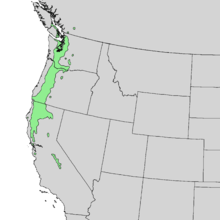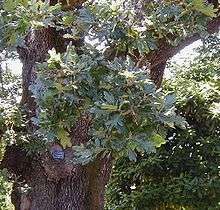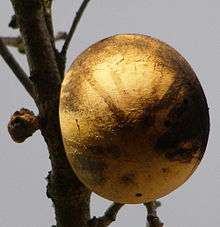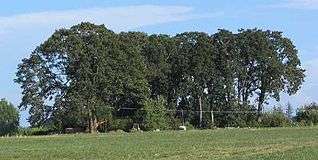Quercus garryana
| Garry oak | |
|---|---|
 | |
| Mature Garry oak | |
.jpg) | |
| Scientific classification | |
| Kingdom: | Plantae |
| (unranked): | Angiosperms |
| (unranked): | Eudicots |
| (unranked): | Rosids |
| Order: | Fagales |
| Family: | Fagaceae |
| Genus: | Quercus |
| Section: | Quercus |
| Species: | Q. garryana |
| Binomial name | |
| Quercus garryana Douglas ex Hook. 1840 | |
 | |
| Natural range | |
| Synonyms[1] | |
|
List
| |
Quercus garryana, the Garry oak, Oregon white oak or Oregon oak, is a tree species with a range stretching from southern California to southwestern British Columbia. It grows from sea level to 210 metres (690 ft) altitude in the northern part of its range, and at 300 to 1,800 metres (980 to 5,910 ft) in the south of the range in California. The tree is named after Nicholas Garry, deputy governor of the Hudson's Bay Company, 1822–35.[2]
Range
In British Columbia, the Garry oak grows on the Gulf Islands and southeastern Vancouver Island, from west of Victoria along the east side of the island up to the Campbell River area. There are also small populations along the Fraser River on the British Columbia mainland.[2]
In Washington state, the garry oak grows on the west side of the Cascade Range, particularly in the Puget Sound lowlands, the northeastern Olympic Peninsula, Whidbey Island and the San Juan Islands. It also grows in the foothills of the southeastern Cascades and along the Columbia River Gorge.[3][4]
In Oregon, the Garry oak grows on the west side of the Cascade Range, primarily in the Willamette, Umpqua and Rogue River valleys, and along the Columbia River Gorge.[3][4]
In California, the garryana variety grows in the foothills of the Siskiyou and Klamath Mountains, the Coast Ranges of Northern California, and of the west slope of the Cascades. The semota variety grows in the Sierra Nevada and Coast Ranges as far south as Los Angeles County.[5]
Varieties
There are three varieties:
- Quercus garryana var. garryana – tree to 20 (30) m. British Columbia south along the Cascades to the California Coast Ranges.
- Quercus garryana var. breweri – shrub to 5 m; leaves velvety underneath. Siskiyou Mountains.
- Quercus garryana var. semota – shrub to 5 m; leaves not velvety underneath. Sierra Nevada.[5]
Growth characteristics
It is a drought-tolerant tree, typically of medium height, growing slowly to around 20 m (occasionally as high as 30 m) or as a shrub to 3 to 5 metres (9.8 to 16.4 ft) tall. It has the characteristic oval profile of other oaks when solitary, but is also known to grow in groves close enough together that crowns may form a canopy. The leaves are deciduous, 5–15 cm long and 2–8 cm broad, with 3-7 deep lobes on each side. The flowers are catkins, the fruit a small acorn 2–3 cm (rarely 4 cm) long and 1.5–2 cm broad, with shallow, scaly cups.
The Oregon white oak is commonly found in the Willamette Valley hosting the mistletoe Phoradendron flavescens. It is also commonly found hosting galls created by wasps in the family Cynipidae. 'Oak apples', green or yellow ball of up to 5 cm in size, are the most spectacular.[6] They are attached to the undersides of leaves. One common species responsible for these galls is Cynips maculipennis. Other species create galls on stems and leaves. Shapes vary from spheres to mushroom-shaped to pencil-shaped.

In British Columbia, the Garry oak can be infested by three nonnative insects: the jumping gall wasp Neuroterus saltatorius, the oak leaf phylloxeran, and the gypsy moth.[2]
While the invasive plant disease commonly called Sudden Oak Death attacks other Pacific Coast native oaks, it has not yet been found on the Garry oak. Most oak hosts of this disease are in the red oak group, while Garry oak is in the white oak group.[7]
Natural History
Garry oak is the only native oak species in British Columbia, Washington, and northern Oregon. In these areas, Garry oak woodlands are seral, or early-successional – they depend on disturbance to avoid being overtaken by Douglas-fir (Pseudotsuga menziesii). The disturbance allowing Garry oak to persist in an area that would otherwise succeed to coniferous forest was primarily fire. Natural wildfires are relatively common in the drier portions of the Pacific Northwest where Garry oak is found, but fire suppression has made such events much less common. In addition, early settlers' records, soil surveys, and tribal histories indicate that deliberate burning was widely practiced by the indigenous people of these areas. Fire perpetuated the grasslands that produced food sources such as camas, chocolate lily, bracken fern, and oak; and that provided grazing and easy hunting for deer and elk. Mature Garry oaks are fire-resistant, and so would not be severely harmed by grass fires of low intensity. Such fires prevented Douglas-fir and most other conifer seedlings from becoming established, allowing bunch grass prairie and Garry oak woodland to persist. Fire also kept oak woodlands on drier soils free of a shrub understory. Wetter oak woodlands historically had a substantial shrub understory, primarily snowberry.[8]

Garry oak woodlands in British Columbia and Washington are critical habitats for a number of species that are rare or extirpated in these areas, plant, animal, and bryophyte:[8][9]
- Propertius duskywing butterfly Erynnis propertius, sole larval food plant is oak
- Bucculatrix zophopasta leaf-mining moth, sole larval food plant is oak
- Lewis woodpecker Melanerpes lewis
- Slender billed nuthatch Sitta carolinensis aculeata
- Sharp tailed snake Contia tenuis
- Western gray squirrel Sciurus griseus
- Western tanager Piranga ludoviciana
- Western wood peewee Contopus sordidulus
- Western bluebird Sialia mexicana
- Sessile trillium Trillium parviflorum
- Banded cord-moss Entosthodon fascicularis
- Apple moss Bartramia stricta
- (liverwort) Riccia ciliata

Garry oak woodlands create a landscape mosaic of grassland, savanna, woodland, and closed-canopy forest. This mosaic of varied habitats, in turn, allows many more species to live in this area than would be possible in coniferous forest alone. Parks Canada states that Garry oak woodlands support more species of plants than any other terrestrial ecosystem in British Columbia.[10] It grows in a variety of soil types, for instance, rocky outcrops, glacial gravelly outwash, deep grassland soils, and seasonally flooded riparian areas.[8][9]
The Donation Land Claim Act of 1850 encouraged Anglo settlement of Washington and Oregon, and marked the beginning of the end of regular burning by Indians of the area (Perdue IN Dunn and Ewing).[8] The arrival of Europeans also reduced the number of natural fires that took place in Garry oak habitat. With fire suppression and conversion to agriculture, Garry oak woodlands and bunch grass prairies were invaded by Douglas-fir, Oregon ash (Fraxinus latifolia), and imported pasture grasses. Oaks were logged to clear land for pasture, and for firewood and fence posts. Livestock grazing trampled and consumed oak seedlings. By the 1990s, more than half the Garry oak woodland habitat in the South Puget Sound area of Washington was gone.[8] On Vancouver Island, more than 90% was gone.[9] Remaining Garry oak woodlands are threatened by urbanization, conversion to Douglas-fir woodland, and invasion by shrubs, both native and nonnative (Scotch broom Cytisus scoparius, sweetbriar rose Rosa eglanteria, snowberry Symphoricarpos albus, Indian plum Oemleria cerasiformis, poison-oak Toxicodendron diversilobum, English holly Ilex aquifolium, bird cherry Prunus avens).[4] Conversely, oak groves in wetter areas that historically had closed canopies of large trees are becoming crowded with young oaks that grow thin and spindly, due to lack of fires that would clear out seedlings.[8]
Uses
Although the wood has a beautiful grain, it is difficult to season without warping, and therefore the Garry oak has not historically been regarded as having any commercial value and is frequently destroyed as land is cleared for development. Recently the wood, which is similar to that of other white oaks, has been used experimentally in Oregon for creating casks in which to age wine. When used as firewood, garry oak produces 28 million BTUs per cord burned.[11]
Conservation
Garry oaks and their ecosystems are the focus of conservation efforts, including communities such as Tacoma, Washington, where an Oak Tree Park has been established, Oak Bay, British Columbia, which is named after the tree, and Corvallis, Oregon.[12] Oak Harbor, Washington, named after the tree and home to Smith Park that contains a dense grove of mature Garry Oak trees, is actively pursuing conservation of the city's namesake tree with the formation of the Oak Harbor Garry Oak Society.[13]
In southwest Washington, significant acreages of Garry oaks are preserved in the Scatter Creek Wildlife Area, in sites such as the Scatter Creek Unit, which contain some of the few remaining areas of south Puget Sound prairie.
In Oak Bay, British Columbia, a fine of up to $10,000 may be issued for each Garry oak tree cut or damaged.[14]
See also
 Media related to Quercus garryana (category) at Wikimedia Commons
Media related to Quercus garryana (category) at Wikimedia Commons- Chionodes petalumensis
References
- ↑ The Plant List, Quercus garryana Douglas ex Hook.
- 1 2 3 "GOERT". Garry Oak Ecosystems Recovery Team. Retrieved 3 February 2011.
- 1 2 "Burke Herbarium". University of Washington. Retrieved 3 February 2011.
- 1 2 3 Franklin and Dyrness (1988). Natural Vegetation of Oregon and Washington. Corvallis, Oregon: Oregon State University Press. ISBN 0-87071-356-6.
- 1 2 "USDA PLANTS Database". United States Department of Agriculture. Retrieved 3 February 2011.
- ↑ Haggard, Peter and Judy (2006). Insects of the Pacific Northwest. Portland, Oregon: Timber Press. ISBN 978-0-88192-689-7.
- ↑ APHIS. "Phytophthora ramorum host list". USDA. Retrieved 6 February 2011.
- 1 2 3 4 5 6 Dunn and Ewing (1997). Ecology and Conservation of the South Puget Sound Landscape. Seattle: The Nature Conservancy.
- 1 2 3 Lea; Miles; McIntosh (2006). "Garry Oak Ecosystem Recovery Team Colloqium" (PDF).
- ↑ Parks Canada. "Garry Oak Ecosystems". Retrieved 7 February 2011.
- ↑ "What is the best firewood to burn". Firewoodresource. Retrieved 14 October 2012.
- ↑ Barnes, Marc (November 2003). "Bald Hill Oak Restoration". Oregon Oak Communities Working Group. Archived from the original on September 12, 2011. Retrieved 11 August 2013.
- ↑ NEWBERRY, RON (April 11, 2015). "Group aims to save Garry oaks". Sound Publishing. Whidbey News Times. Retrieved 3 October 2015.
- ↑ "Trees on Your Property - An Information Guide to Oak Bay's Tree Protection Bylaw" (PDF). Oak Bay B.C. Retrieved 18 April 2012.
External links
- Garry Oak Ecosystems Recovery Team: Information about native plant gardening, propagation, removing invasive plants and events for beginners to professionals.
- Flora of North America: Quercus garryana
- Plants of British Columbia: Quercus garryana
- Jepson Flora Project: Quercus garryana
- Province of British Columbia – Ministry of Environment: Garry Oak Ecosystem – PDF
- Province of British Columbia – Ministry of Forests, Lands and Natural Resource Operations: Garry Oak